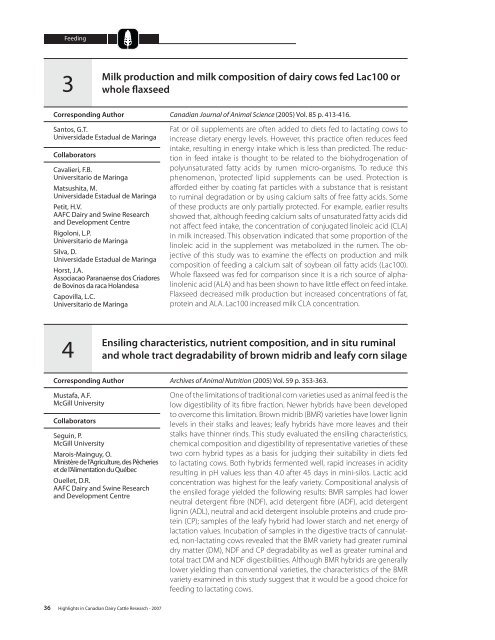A52-75-2007E.pdf - AgroMedia International Inc
A52-75-2007E.pdf - AgroMedia International Inc
A52-75-2007E.pdf - AgroMedia International Inc
Create successful ePaper yourself
Turn your PDF publications into a flip-book with our unique Google optimized e-Paper software.
Feeding3Milk production and milk composition of dairy cows fed Lac100 orwhole flaxseedCorresponding AuthorSantos, G.T.Universidade Estadual de MaringaCollaboratorsCavalieri, F.B.Universitario de MaringaMatsushita, M.Universidade Estadual de MaringaPetit, H.V.AAFC Dairy and Swine Researchand Development CentreRigoloni, L.P.Universitario de MaringaSilva, D.Universidade Estadual de MaringaHorst, J.A.Associacao Paranaense dos Criadoresde Bovinos da raca HolandesaCapovilla, L.C.Universitario de MaringaCanadian Journal of Animal Science (2005) Vol. 85 p. 413-416.Fat or oil supplements are often added to diets fed to lactating cows toincrease dietary energy levels. However, this practice often reduces feedintake, resulting in energy intake which is less than predicted. The reductionin feed intake is thought to be related to the biohydrogenation ofpolyunsaturated fatty acids by rumen micro-organisms. To reduce thisphenomenon, ‘protected’ lipid supplements can be used. Protection isafforded either by coating fat particles with a substance that is resistantto ruminal degradation or by using calcium salts of free fatty acids. Someof these products are only partially protected. For example, earlier resultsshowed that, although feeding calcium salts of unsaturated fatty acids didnot affect feed intake, the concentration of conjugated linoleic acid (CLA)in milk increased. This observation indicated that some proportion of thelinoleic acid in the supplement was metabolized in the rumen. The objectiveof this study was to examine the effects on production and milkcomposition of feeding a calcium salt of soybean oil fatty acids (Lac100).Whole flaxseed was fed for comparison since it is a rich source of alphalinolenicacid (ALA) and has been shown to have little effect on feed intake.Flaxseed decreased milk production but increased concentrations of fat,protein and ALA. Lac100 increased milk CLA concentration.4Ensiling characteristics, nutrient composition, and in situ ruminaland whole tract degradability of brown midrib and leafy corn silageCorresponding AuthorMustafa, A.F.McGill UniversityCollaboratorsSeguin, P.McGill UniversityMarois-Mainguy, O.Ministère de l’Agriculture, des Pêcherieset de l’Alimentation du QuébecOuellet, D.R.AAFC Dairy and Swine Researchand Development CentreArchives of Animal Nutrition (2005) Vol. 59 p. 353-363.One of the limitations of traditional corn varieties used as animal feed is thelow digestibility of its fibre fraction. Newer hybrids have been developedto overcome this limitation. Brown midrib (BMR) varieties have lower ligninlevels in their stalks and leaves; leafy hybrids have more leaves and theirstalks have thinner rinds. This study evaluated the ensiling characteristics,chemical composition and digestibility of representative varieties of thesetwo corn hybrid types as a basis for judging their suitability in diets fedto lactating cows. Both hybrids fermented well, rapid increases in acidityresulting in pH values less than 4.0 after 45 days in mini-silos. Lactic acidconcentration was highest for the leafy variety. Compositional analysis ofthe ensiled forage yielded the following results: BMR samples had lowerneutral detergent fibre (NDF), acid detergent fibre (ADF), acid detergentlignin (ADL), neutral and acid detergent insoluble proteins and crude protein(CP); samples of the leafy hybrid had lower starch and net energy oflactation values. <strong>Inc</strong>ubation of samples in the digestive tracts of cannulated,non-lactating cows revealed that the BMR variety had greater ruminaldry matter (DM), NDF and CP degradability as well as greater ruminal andtotal tract DM and NDF digestibilities. Although BMR hybrids are generallylower yielding than conventional varieties, the characteristics of the BMRvariety examined in this study suggest that it would be a good choice forfeeding to lactating cows.36 Highlights in Canadian Dairy Cattle Research - 2007





